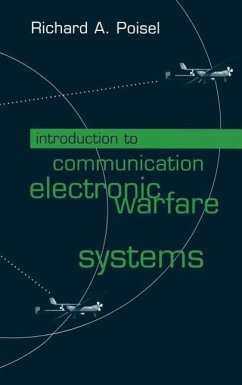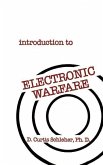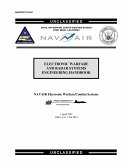This comprehensive engineering-level resource provides you with an excellent introduction to electronic warfare (EW) for communication systems. Extensively referenced with over 600 equations, it details the components, systems, and operations of electronic warfare systems dedicated to protecting and attacking military communications networks. You are provided with a complete understanding of how modern direction finders for communication signals work, along with their limitations.
Table of content:
Communication Electronic Warfare Systems -- Electronic Support. Electronic Attack. Typical EW System Configuration. Electromagnetic Signal Propagation -- Introduction. Signal Propagation. Radio Frequency Band Designations. Polarization. Power Density Free Space Propagation. Direct Wave. Wave Diffraction. Reflected Waves. Surface Wave. Ducting. Meteor Burst. Scattering. Characteristics of the Tactical RF Channel. Propagation via the Ionosphere. Noise and Interference -- Introduction. Thermal Noise. Internal Noise Sources. External Noise Sources. Co-Channel and Multipath Interference. Communication Technologies -- Introduction. Modulation. Coding of Communication Signals. Modems. Facsimile. Communication Security. System Engineering -- Introduction. System Engineering. Electronic Support -- Introduction. Intercept. Geolocation. Triangulation with Multiple Bearings. Deployment Considerations. Electronic Mapping. Common Operational Picture. Operational Integration with Other Disciplines. Support to Targeting. Electronic Attack -- Introduction. Communication Jamming. Jammer Deployment. Look Through. Analog Communications. Digital Communications. Narrowband/Partial Band Jamming. Barrage Jamming. Jamming LPI Targets. Follower Jammer. Antennas -- Introduction. Isotropic Antenna. Antenna Gain. Wire Antennas. Active Antennas. Aperture Antennas. Genetically Designed Antennas. More on Antenna Gain. Receivers -- Introduction Receivers. Types of Receivers. Signal Processing -- Introduction. Orthogonal Function. Transforms. Cyclostationary Signal Processing. Higher Order Statistics. Applications. Direction Finding Position Fixing Techniques -- Introduction. Bearing Estimation. Position Fixing Algorithms. Single Site Location Techniques. Fix Accuracy. Fix Coverage. Hyperbolic Position Fixing Techniques -- Introduction. Time Difference of Arrival. Differential Doppler. Cross Ambiguity Function. Time of Arrival. Exciters and Power Amplifiers -- Introduction. Exciters. Power Amplifiers. Early Entry Electronic Support -- Introduction. Target Model. Intercept System Model. Simulation Results. Detection and Geolocation of Frequency Hopping Emitters -- Introduction. Analysis. Simulation. Signal Detection Range -- Introduction. Noise Limits on Detection Range. Targets. Detection Range With the Propagation Model. Detection Range with the RP Propagation Model. Electronic Attack-UAV and Ground Based -- Introduction. Signal Propagation at Long Ranges. Jammer ERP. Targets. Radio Line of Sight. UAV Jammer. Ground Based Jammer. Expendable Jammer. Appendix A -- Random Variables and Probability. Introduction. Means, Expected Values and Moment Functions of Random Variables. Probability. Gaussian Density Functions. Kurtosis. Skewness. Useful Characteristics of Probabilities, Density Functions and Distribution Functions. Appendix B -- Simulation Networks.
Hinweis: Dieser Artikel kann nur an eine deutsche Lieferadresse ausgeliefert werden.
Table of content:
Communication Electronic Warfare Systems -- Electronic Support. Electronic Attack. Typical EW System Configuration. Electromagnetic Signal Propagation -- Introduction. Signal Propagation. Radio Frequency Band Designations. Polarization. Power Density Free Space Propagation. Direct Wave. Wave Diffraction. Reflected Waves. Surface Wave. Ducting. Meteor Burst. Scattering. Characteristics of the Tactical RF Channel. Propagation via the Ionosphere. Noise and Interference -- Introduction. Thermal Noise. Internal Noise Sources. External Noise Sources. Co-Channel and Multipath Interference. Communication Technologies -- Introduction. Modulation. Coding of Communication Signals. Modems. Facsimile. Communication Security. System Engineering -- Introduction. System Engineering. Electronic Support -- Introduction. Intercept. Geolocation. Triangulation with Multiple Bearings. Deployment Considerations. Electronic Mapping. Common Operational Picture. Operational Integration with Other Disciplines. Support to Targeting. Electronic Attack -- Introduction. Communication Jamming. Jammer Deployment. Look Through. Analog Communications. Digital Communications. Narrowband/Partial Band Jamming. Barrage Jamming. Jamming LPI Targets. Follower Jammer. Antennas -- Introduction. Isotropic Antenna. Antenna Gain. Wire Antennas. Active Antennas. Aperture Antennas. Genetically Designed Antennas. More on Antenna Gain. Receivers -- Introduction Receivers. Types of Receivers. Signal Processing -- Introduction. Orthogonal Function. Transforms. Cyclostationary Signal Processing. Higher Order Statistics. Applications. Direction Finding Position Fixing Techniques -- Introduction. Bearing Estimation. Position Fixing Algorithms. Single Site Location Techniques. Fix Accuracy. Fix Coverage. Hyperbolic Position Fixing Techniques -- Introduction. Time Difference of Arrival. Differential Doppler. Cross Ambiguity Function. Time of Arrival. Exciters and Power Amplifiers -- Introduction. Exciters. Power Amplifiers. Early Entry Electronic Support -- Introduction. Target Model. Intercept System Model. Simulation Results. Detection and Geolocation of Frequency Hopping Emitters -- Introduction. Analysis. Simulation. Signal Detection Range -- Introduction. Noise Limits on Detection Range. Targets. Detection Range With the Propagation Model. Detection Range with the RP Propagation Model. Electronic Attack-UAV and Ground Based -- Introduction. Signal Propagation at Long Ranges. Jammer ERP. Targets. Radio Line of Sight. UAV Jammer. Ground Based Jammer. Expendable Jammer. Appendix A -- Random Variables and Probability. Introduction. Means, Expected Values and Moment Functions of Random Variables. Probability. Gaussian Density Functions. Kurtosis. Skewness. Useful Characteristics of Probabilities, Density Functions and Distribution Functions. Appendix B -- Simulation Networks.
Hinweis: Dieser Artikel kann nur an eine deutsche Lieferadresse ausgeliefert werden.








